Video: How a large dairy is keeping youngstock mortality low
A large US dairy is achieving exceptionally low mortality rates of 1% in its pre-weaned calves, and hitting daily growth rates of 800g up to weaning.
About 1,800 calves will be on milk at any one time at Cow Palace Dairy in Washington State, with nine employees responsible for caring both for them and the remaining youngstock, aged up to four months.
Read the report and watch the video on dehorning below.
See also: Advice on cutting dairy ration costs this winter
Having so many to feed at once makes it a military operation, but at no point does it ever compromise animal welfare, with the dairy running mortality rates within the top 1% of performance within the US.
“I have a couple of rules regarding baby calves. But the main thing is I want people to think about them as babies and, if you do, you get people to think about how they treat them differently.
“It all starts right here,” says Scott Abbott, from Dairy Vet Management, based in Washington, and director of technical services at World Wide Sires.
Housing
There is growing pressure in the US, like in the UK, for calves to be grouped together.
But to strike a balance between animal welfare concerns and maintaining high health standards, the farm uses individual hutches in bays of three so calves can have some contact with each other.
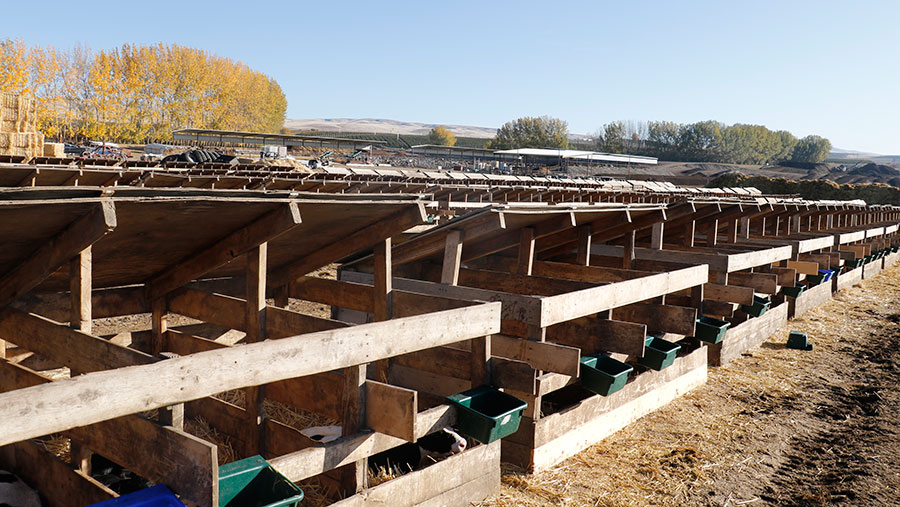
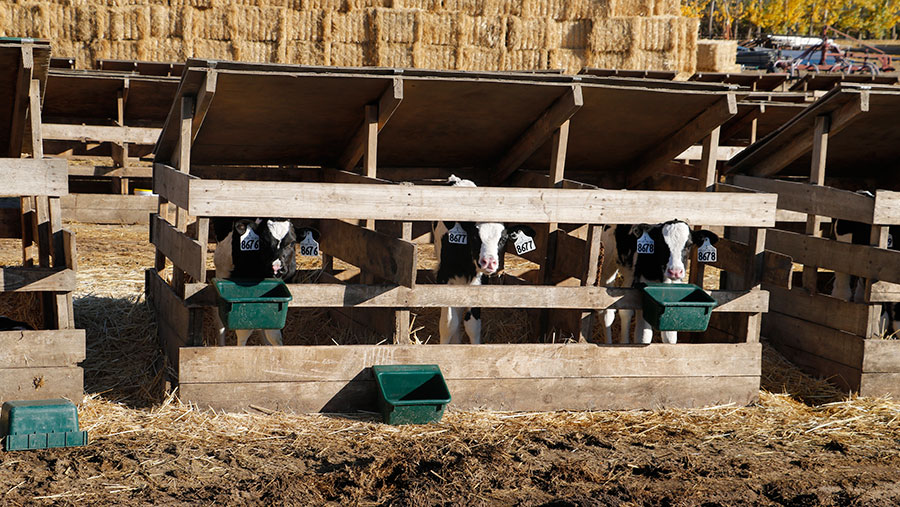
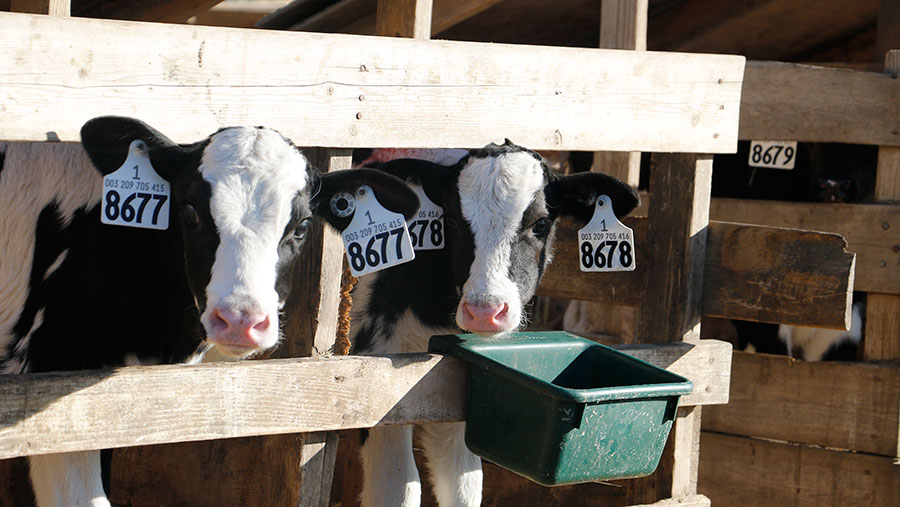
There is no legal size requirements in the US, unlike in the UK, but even so, Cow Palace aims to set its own standards.
“We are going to increase the size of the hutch because of animal welfare concerns and put two calves [per bay] so it’s bigger. There’s a large movement to group calves together from an early age, but I’m a vet and disease spreads by contact.
“Having animals in hutches reduces the disease threat. We want to keep contact with each other to improve socialisation, but we are trying to keep calves healthy,” says Dr Abbott.
Calves normally remain in one hutch until weaning, but in the winter, heavy snow and higher rainfall means they often have to move them to a fresh hutch to keep them clean.
However, hot summer temperatures of up to 40C mean the wooden hutches result in better performance, despite them being harder to clean than plastic ones.
“We clean them with a pressure washer using an alkalising chlorine solution.
“Plastic hutches are better, no question about it, because they are easier to clean, but we actually have higher sickness levels in them because in the summer they get hot and the air movement isn’t great because they have solid sides,” says Dr Abbott.
Calves are bedded with plenty of fresh straw two to three times weekly using a small tractor and trailer – one person drives while another beds down using a hatch at the back of the hutch.
“Everyone talks about building calf barns. These hutches are nothing special. The number one thing is keeping calves dry and warm,” adds Dr Abbott, who places a strong emphasis on protocols.
Dehorning
Calves used to be dehorned aged two months with a hot iron, but the farm has switched to dehorning at two to four days old using a paste.
They believe it is much less stressful for the calves and the staff, with the procedure taking a matter of minutes.
Calves are given a painkiller in their milk before being restrained using a portable head lock. Hair is pre-cut and the paste is applied to the skin covering the horn bud.
Watch how calves are dehorned using paste at Cow Palace.
On average, only one in 400 calves require a partial dehorn at a later stage.
Feeding
Milk is fed using a motorised “milk taxi” and a high-volume nozzle to dispense the liquid. At the front of the taxi is a hopper containing starter pellets that are fed at the same time.
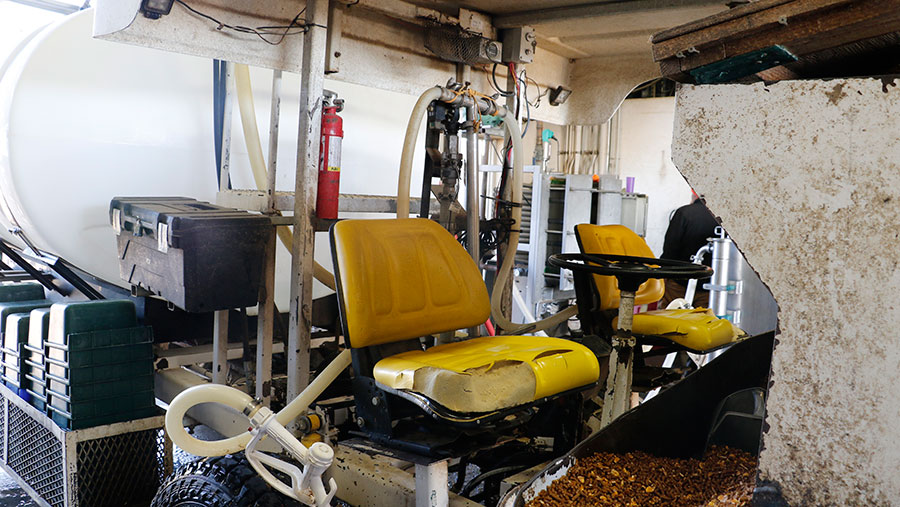
Milk is pasteurised to 63C and each batch is measured using a refractometer to test solids. Milk powder is added to ensure it is consistent and fed each day at 13% milk solids at 40C.
They farm feeds calves high volumes of milk as early as possible; by 15 days calves will be on 10 litres right up until weaning.
Although “a handful” of grain is offered from the start, calves don’t start eating significant amounts until day 20-25.
Starter is expensive, but the business sees it as a good investment to help drive early growth when it’s most efficient.
The farm’s philosophy is: “1kg of extra weight gained pre-weaning is worth 200 litres of milk later in life.”
Starter comprises flaked maize, soya protein and molasses, and although small amounts of chopped alfalfa hay is introduced to the ration after weaning, significant amounts of forage aren’t fed until much later in life, when the rumen is fully developed.
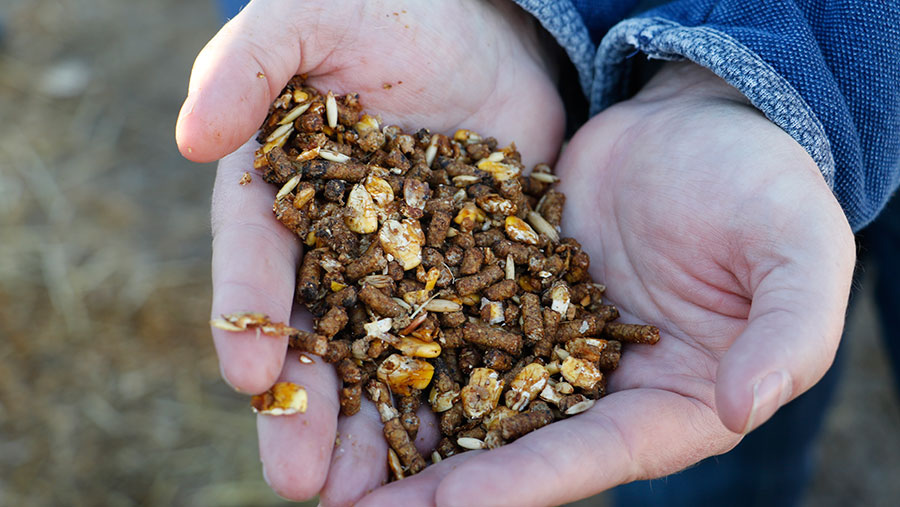
“We want to drive that first 30 days to get calves to grow really well and build their strength. A lot of the time, when we put calves on milk powder, they are on low energy and we expect them to do better, which is why we like to keep them on milk.”
Forage
The rumen doesn’t fully develop in a calf until 12 weeks and the omasum – which processes fibre – isn’t fully developed until six months.
Therefore, forage is slowly built up in calf rations from 65 days, with alfalfa hay being offered rather than straw, because Dr Abbott says the nutritional quality of straw is so low.
About 20% of chopped alfalfa is mixed in with pellets post weaning.
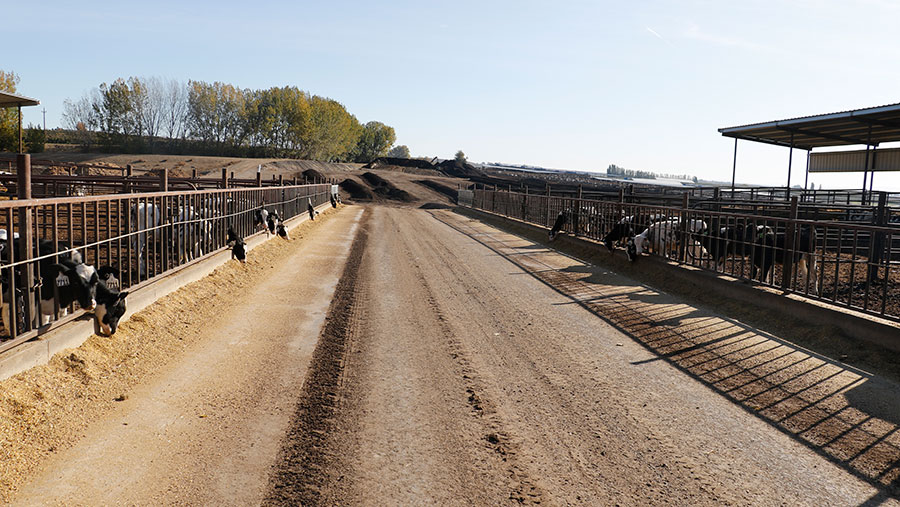
“You don’t see ‘hay bellies’ on these calves. We want to see a little bit of the back bone. Calves that have a lot of forage have a lot sharper back bone and the ribs are sticking out.
“That’s because we’re trying to make them forage digesters when they are not forage digesters,” adds Dr Abbott.
Dr Abbott says “hay bellies” are caused by forage expanding the intestine, not the rumen, because it is not fully developed.
About the Global Training Centre
The Global Training Centre is owned by breeding company World Wide Sires and offers management and reproductive training to people working within the dairy industry.
Training is delivered by the WWS team of vets and advisers and is a balance of classroom presentations and practical training on working dairy farms in Washington state.
For additional information on the availability and cost of courses, contact Michael Halliwell at mhalliwell@wwsires.co.uk or 07710 474 145.
Heifer-rearing site
At four months, calves are moved to a heifer-rearing facility about 35 miles away.
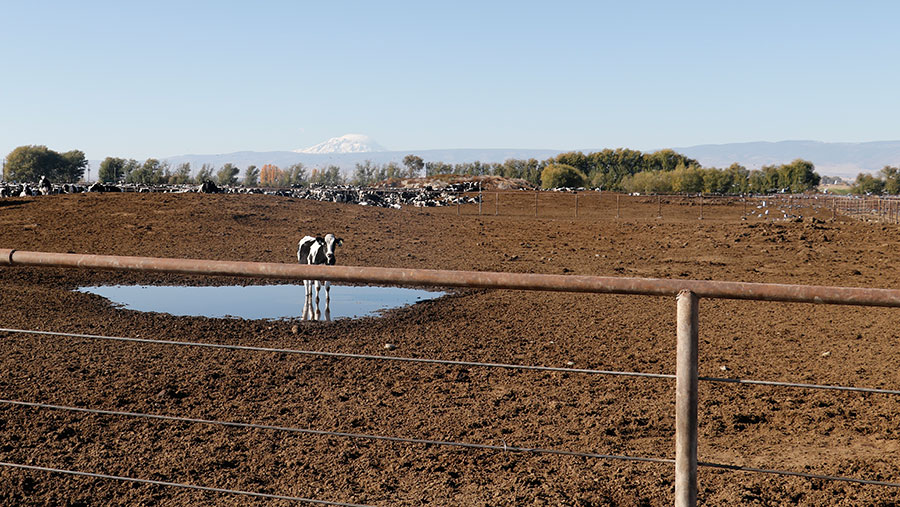
Heifers are bred at 12-12.5 months. They receive one shot of estrumate and are bred every two weeks. Anything not bred or seen in heat receives prostaglandin.
Embryos are used on the bottom end of heifers and everything else receives three services to sexed semen and then beef.
Any small heifers or non-breeders after 18 months will be sold at auction, although the numbers are low.
“We know if there is one too small in the breeding pens when you put them in the lockups, and we don’t mess around – we just sell her,” says youngstock manager Josh Johnston.
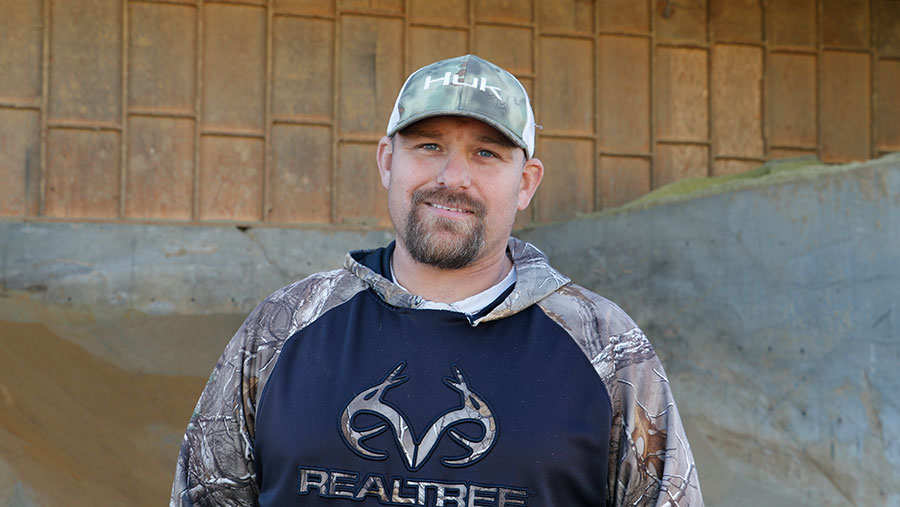
Youngstock manager Josh Johnston
Heifers only have three ration changes the whole time they are at the heifer-rearing site, each introduced gradually. Every pen is numbered, so the feed operator knows requirements and can record allocations.
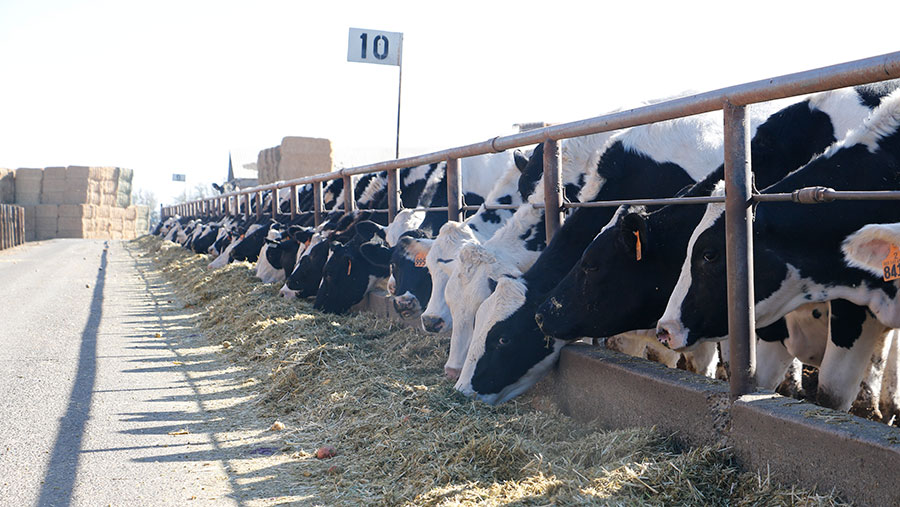
Mr Johnston is able to keep feed costs low at £1.09 a head a day by making the most of waste feed products from nearby farms and factories.
The unit receives thousands of tonnes of free waste apples and potatoes, which are used in rations to feed heifers from eight months.
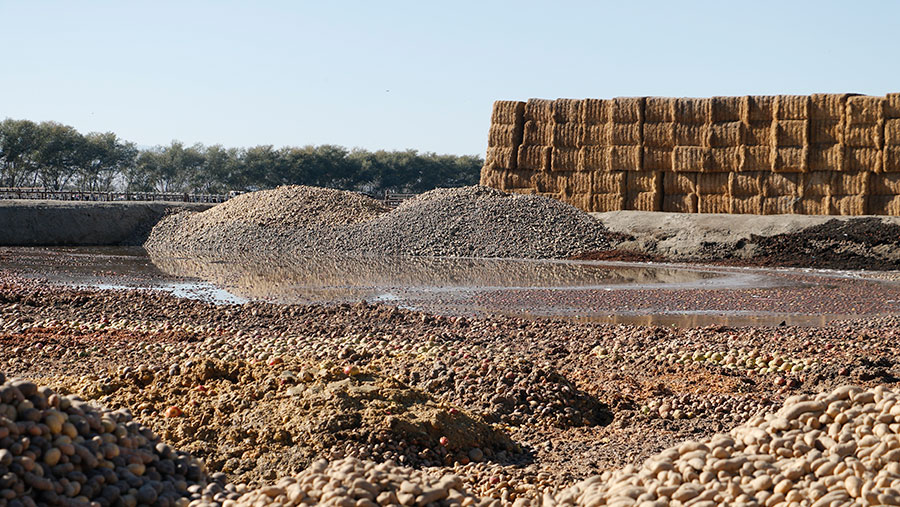
Heifers don’t start receiving significant amounts of forage or pulp until they are weighing about 272kg at eight months.
“Anything before that we end up with issues. Our wet feed is pretty variable and that’s part of the reason we can’t feed it any younger, but the bigger animals can handle the changes.
“Once we get them to 600lb [272kg] we can feed them anything and they are going to grow.
“The reason the feedlot is here is because of the access to this feed. They want to get rid of it and we are big enough to take it all.
“What’s in this will vary from load to load, that’s why we watch the pens from day to day. But on the plus side, it’s free,” adds Mr Johnston.
Sometimes older animals can be prone to getting a bit fat on the pulp ration, so they are limit fed and watched closely.
Mr Johnston says good early growth is the cornerstone to their success, with growth weights averaging 900g from entry to exit and less than 5% open at 18 months.
“What makes it successful is for the first six months, the calves are taken care of. Honestly, our biggest issue is it’s too easy to get them to grow.”
Protocols for management of baby calves
Pre-weaning management
- Tube-feed four litres of fresh colostrum measuring more than 24 on a refractometer within the first two hours of birth with calf and cow ID, colostrum reference and score and the person administering the feed documented on a report card.
- Calves are transferred to a heated straw barn, where their navels are dipped with iodine and they are tagged.
- They receive a further two litres eight to 12 hours later.
- Calves are moved to wooden hutches.
- They receive their first pneumonia vaccine.
- Calves’ blood serum protein levels are checked when they are no more than five days old to check if colostrum management has been successful.
- They are fed three litres of pasteurised milk twice daily until they are 15 days old, and this increases to five litres twice daily until 56 days, when they drop to once-a-day feeding for five days.
- Calves are weaned at 65-67 days
- Starter pellet with 20-22% crude protein (CP) offered from day one.
- The target is to have doubled the calves’ birthweight by weaning. Small calves will be held back until they have met this target and there is a hospital bay for sick calves.
Post-weaning management
- After weaning (60-90 days), calves are transferred to open lots. Shelter is provided in the form of an open-sided barn filled with straw.
- Calves stay on the same ration for one week while they acclimatise to being in groups of 16.
- The ration is gradually altered over five days, with protein dropping to 20% and 20% of chopped alfalfa hay included, no wider than muzzle width.
- Heifers and bulls are kept in different pens.
Three to four months
- Calves are moved into a second open-lot facility, where the group sizes increase to 180 head a pen.
- Shelter is still provided in the form of an open-sided barn filled with straw.
- Calves stay on the same ration, but crude protein drops to 18%, with alfalfa hay maintained at 20% inclusion.
Over four months
- Bulls are sold and heifers moved to a separate rearing site about 34 miles away.
- Heifers arrive weighing 136kg at four months and leave weighing 660kg at 20 months.
- Weighed on arrival and when they leave using truck weights. Individual animal weights aren’t recorded, because it’s time-consuming and stresses the animals.
- Heifers are rested for two weeks and then receive a pneumonia booster, a magnet and vaccination for pink eye.
- Fed four rations: First is the same one fed at Cow Palace before they arrive (18% CP and 20% alfalfa). Second diet change sees protein decrease to 16% and forage inclusion lift to 40%. Third ration is when heifers are introduced to wet feed (eight months+) and more forage is introduced (silage, apples, potatoes, hay, straw and soya in the form of maize distillers’ (15% CP and 43% pulp). In the fourth ration, some of the soya is replaced with a hop pellet (14% CP and 45% pulp) to prevent the animals putting on too much weight.
- Heifers are bred at 12-12.5 months.
- Anything still open at 18 months will be sold.
- Heifers are pregnancy checked at 32 days and reconfirmed at 80 days.
- They will then be confirmed pregnant once more, four days before going back to Cow Palace at 230-235 days in-calf.
- The farm receives 230 heifers every two weeks, depending on calving cycles, and aims to send back 300 in-calf heifers monthly to calve. Extra animals are currently sold as breeding stock.
